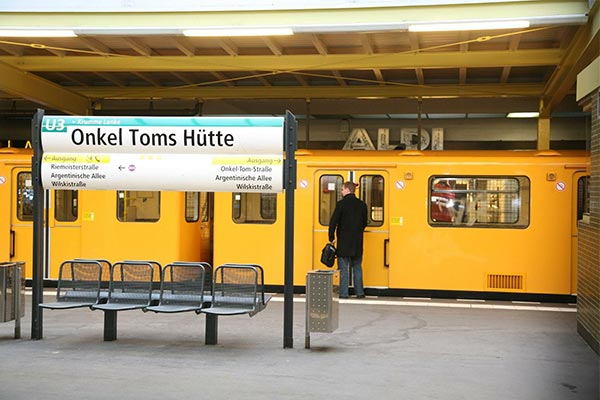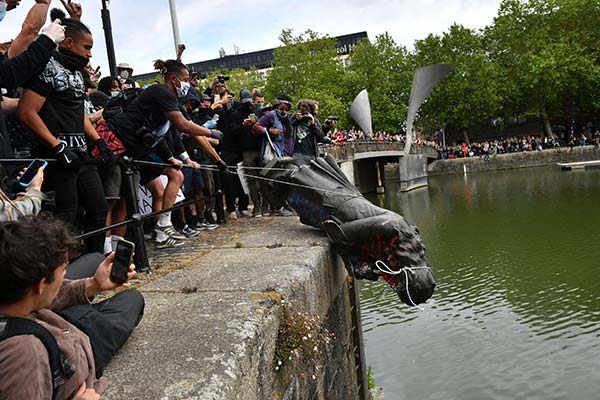Subtotal: $
Checkout
A Time to Break Down, and a Time to Build Up
A German View on Antiracist Protests, Conflicting Politics of Remembrance, and Christian Vocation
By Roger Mielke
April 15, 2021
In Berlin’s Zehlendorf district, there is a subway station named “Onkel Toms Hütte,” after Harriet Beecher Stowe’s famous novel Uncle Tom’s Cabin. Stowe, an ardent abolitionist, wrote the novel in 1852 as a manifesto against slavery. Twenty-two-year-old Berlin pro basketball player Moses Pölking, son of a Cameroonian mother and German father, reads the novel differently. As a person of color, he finds it downright offensive – at the very least, he considers its title character a product of implicit racism. For Pölking, the book portrays a self-degrading Black man the author carefully crafted for her contemporaries so he wouldn’t appear threatening to a White society of slave owners. Pölking started an online petition to change the station’s name, which soon garnered over thirteen thousand signatures.
“Everything has its time,” says the beginning of the famous third verse of Ecclesiastes. Monuments are erected and monuments are torn down – when the time has come: the monument to slave trader Edward Colston in Bristol, the statue of Cecil Rhodes in front of Oriel College in Cambridge, and in Antwerp the statue of Leopold II, the Belgian king who committed atrocities in the Congo. Those seem clearly justified. But what about the monument to Winston Churchill, who in 1940 maintained the Resistance against Hitler and National Socialist Germany? Should his monument be preserved in remembrance of his fight for free democracy? Or should it be removed from sight because Churchill was also an apologist for British colonialism, and much of what he said reveals his deep-seated racism?
“Never again,” or “No more war, no more Auschwitz,” is a fundamental ethical consensus in German politics.
Such conflicting views can hardly be resolved in any clear-cut way. Monuments stand for collective identities, and have the power to shape social identities in turn. For those who build them, monuments affirm the self-representation of a community through its exemplary individuals; for those who tear them down, their toppling represents a marginalized group’s struggle to be seen, heard, and recognized.
Amid this reckoning, aspects of the Christian tradition – which has all too often been misused as an ideology of domination – are also up for debate. On one side, identitarian rhetoric that defends “the Christian West” to draw lines of demarcation is widely on display; in reaction, many voices seeking freedom from oppression reject the Christian message altogether. But the Christian faith can be something else entirely: an important resource for inclusion, liberty, and justice.
The German protests in a global context
Early last summer, hundreds of thousands of demonstrators took to the streets of German cities, protesting not only George Floyd’s killing under the banner of the Black Lives Matter movement, but also denouncing structural racism more broadly. In Germany, the focus is on the recent increase in anti-Semitic and anti-immigrant violence, often committed by well-networked right-wing extremists. Most lethally, on February 19, 2020 in Hanau, a gunman targeting immigrants killed nine people and wounded several more. Germany has also been grappling with crimes committed by the National Socialist Underground, a series of nine xenophobic murders committed between 2000 and 2006, which brought the state under suspicion of complicity. The criminal trial, concluded only in 2018, uncovered the involvement of Germany’s domestic security agency, as well as law enforcement’s negligent misconduct in prior investigations. Evidence showing widespread, deep-rooted police involvement heightened public distrust of the authorities.

Photograph from tagesspiegel.de
The antiracist demonstrations in the summer of 2020 built on a growing movement, especially after the refugee crisis of 2015, which led a broad swath of German society to mobilize. The influx of asylum seekers pushed the administration to its limits. Chancellor Angela Merkel’s famous dictum Wir schaffen das – “We can do it” – could only be fulfilled by the extraordinary commitment of countless volunteers, especially on the local level. Church networks were essential to this effort.
Meanwhile, support for the right-wing populist AFD (Alternative for Germany) party reached record levels in 2018, and by 2019 the AFD had replaced the Social Democrats as the leading party among working-class German voters. In opposition to the rise of far-right populism and the mounting polarization of German society, an October 2018 demonstration in Berlin attracted 240,000 attendees under the slogan Wir sind mehr – a phrase with a two-fold meaning, both “there are more of us” and, literally, “we are more.” Both the large number of demonstrators and the right-wing populists’ electoral successes, however, show just how polarized Germans really are. After 2015, the three-fold topic of migration, refugees, and asylum remained an ongoing debate, and marked the fault line along which opposing political camps formed.
In 2019, public attention shifted to climate policy, and Fridays For Future demonstrations proved that Germany’s young generation was becoming more politically engaged than it had been since the anti-nuclear weapons protests in the early 1980s.
In 2020, another seismic shift occurred. At first, the Covid-19 pandemic silenced civic engagement. Germany’s government administration and state-run healthcare stepped to the fore, and could count on overwhelming approval for decisive action. In light of the pandemic, it was easy to think polarization was a thing of the past – a notion Germany’s post-election exit polls seemed to prove, showing a large majority of people were in favor of the chancellor’s ruling party, the Christian Democrats and Christian Socialists (CDU/CSU). This makes the level of engagement in German Black Lives Matter protests even more remarkable. Such vast mobilization will likely have a lasting influence on German politics.
The moral of these stories of healing and exorcism is the patient power of inclusion – the acts by which Jesus brings wounded people back into the community.
German society, which prior to the new millennium had been relatively ethnically homogeneous, is increasingly accepting its status as a society of immigrants, and has even begun speaking of a “post-migrant era” where people’s ethnic backgrounds no longer determine how they are treated and perceived. Nevertheless, this new national self-image remains highly fraught, and there is more change to come. With the foreseeable decline of heavy industry due to the climate crisis, the number of people who feel left behind by globalization will increase. The same goes for the ongoing evolution of classic gender roles due to changes in the dynamics of both knowledge and service-based economies. The clash between a fast, dynamic, outward-oriented, global culture of individual human rights and a slow, retrograde, deeply rooted culture of collective belonging will produce many points of rupture, overlap, and combination. Germany’s identity debate is growing ever more confusing.
Remembrance and political public discourse
As Germany struggles to define its identity, how relics from the National Socialist era are dealt with plays an important role – not only with regard to material legacies, but also regarding how to adequately acknowledge Nazi crimes that have become a part of every German’s own historical self-image. Broad social consensus on this point is only called into question on the far right of the political spectrum. Vast architectural complexes, such as the parade grounds where the Nazis’ Nuremberg rallies were held, can hardly just be razed and erased from the collective memory. They remain standing, serving as striking museums and forums for the study of democracy. Berlin’s Holocaust memorials – literally known as “memorials to the victims of National Socialist terror” – serve as examples of the alternative. Intense public debate surrounded the design of these monuments, with various sides fighting over what constituted appropriate formal and symbolic choices.
The Neue Wache or “New Guardhouse” – designed by Prussian architect Karl Friedrich Schinkel and built on Unter den Linden, one of the city’s most magnificent boulevards – is now officially the “Central Memorial of the Federal Republic of Germany for the Victims of War and Tyranny.” In the early 1990s, Chancellor Helmut Kohl suggested the bronze sculpture Mother with Her Dead Son, by pacifist sculptor Käthe Kollwitz, be installed inside the memorial. When it was installed, the fact that the sculpture’s form clearly referenced the Christian iconography of the pietà – Mary mourning Jesus, her dead son – sparked intense debate. It was seen as disrespectful of the Jewish and Communist victims of National Socialism. Perhaps the most intriguing aspect of this memorial is its many revisions and reinterpretations: originally conceived in 1818 as a Prussian memorial to the German Campaign of 1813 (known in German as the Befreiungskriege or “Liberation Wars”), its interior was redesigned in 1931, creating a much simpler space, and rededicated to the fallen soldiers of World War I; soon thereafter, the National Socialists used it for their own propagandistic purposes, and then it was heavily damaged during World War II bombings; in 1960 the East German government again rededicated it, as a “Memorial to the Victims of Fascism and Militarism”; the Communist regime also removed the cross – an overtly Christian symbol.
Just a few hundred meters from the Neue Wache stands the Memorial to the Murdered Jews of Europe, an expanse of 2,711 concrete stelae designed by Peter Eisenman and inaugurated in 2005. Its emphatic lack of imagery refuses all attempts at interpretation, making it an exact conceptual counter to the Neue Wache’s pietà, which invites the viewer to identify with it emotionally. (The memorial is made somewhat more accessible through its information center, which offers seminars and guided tours.)
Despite all their design-related controversies, these monuments all express broad social agreement regarding the politics of remembrance: Nie wieder Krieg, nie wieder Auschwitz – “Never again,” or “No more war, no more Auschwitz” – is a fundamental ethical consensus in German politics. This sets these monuments apart from the controversial statue in Bristol, for example, and from the disputes over the Confederate flag in the southern United States.
Yet another memorial site not far from Berlin hasn’t met with such consensus: the Garrison Church in Potsdam, the Prussian royal seat with several palaces and parks. On March 21, 1933, the Garrison Church was where the old-guard Prussian elites shook hands with Adolf Hitler, signaling their approval of National Socialism. The church was badly damaged in 1945, and in 1968 the East German regime blew up its ruins, a showy gesture meant to send another signal. The tower’s planned reconstruction is ostensibly part of a broader project to restore every major historical building in Potsdam’s city center, but remains highly controversial. Germany’s Protestant Church and an association supported by several prominent individuals want to see it rebuilt as a “place to learn about peace,” and have established a reconciliation chapel and education center in a temporary building nearby. Vocal critics, including other church groups, view the reconstruction primarily as a rehabilitation of the old militaristic coalition between church and state.

Protesters throwing a statue of Edward Colston into Bristol harbor during a Black Lives Matter protest rally. Photograph by Ben Birchall/Alamy
The reconstruction of the Prussian Royal Palace in Berlin sparked similar controversies. It, too, had been blown up by the East German regime, which proceeded to build its parliament, the “Palace of the Republic,” on the same spot; it was then demolished to rebuild the former palace, albeit with a new interior behind the historical facade, as the Humboldt Forum. The inclusion of Christian symbolism heightened the controversy: the palace dome is topped by a cross, and a Bible verse rings its base: “So that at the name of Jesus every knee should bend, in heaven and on earth and under the earth” (Phil. 2:10). Is this merely a historical reconstruction, or a current claim to power coming from a disavowed ruling ideology dressed up to appear Christian?
These ongoing acts of overwriting and reinterpreting burdensome aspects of history reveal the complex process required to reach mutual understanding in a pluralistic society.. Community and the democratic society underpinning it can thrive on discourse when there a shared language in which to argue. But political public discourse is fragile – it must be fostered and maintained, again and again. Even from an ideal viewpoint, two challenging possibilities arise. First, previously unquestioned traditions suddenly appear to aggravate social conflict, resulting in societal shifts of meaning. For example, the Christian St. Martin’s Eve becomes a religion-neutral festival of lights, and Christmas markets are rebranded as more generic holiday markets. Traditions are progressively diluted until they are no longer considered cause for offense. The second possibility: members of society solidify their identity markers, thus relying on cultural and political boundaries that are more or less concrete.
Both strategies – either neutralize cultural traditions, or render them absolute – are misguided, because they increase social division and exclude honest debate. Digital media have also altered modes of public discourse, making communication both easier and more difficult at the same time.
A Christian ethic of presence
What salutary resources can churches and Christian communities bring to the table to ease the tensions between antiracist protesters, or those promoting universalist ethics, and those who identify with a populist counterrevolution?
One restorative resource is the messianic principle of nonviolence, which we encounter in the faith-healing stories of the Gospels. More than just an ethical concept, it’s a historically powerful practice: the fruit of constant rereading of these iconic Gospel stories over many centuries, which is then incorporated into the social order and political institutions, has thereby also become an essential element in the history of modern free societies. The crux of these narratives is the proclamation “the kingdom of God has come near” (Mark 1:15). This proclamation is borne out in Jesus’ authority over the forces of disease, death, and demons. The moral of these stories of healing and exorcism is the patient power of inclusion – the acts by which Jesus brings wounded people back into the community.
In whatever political order they find themselves, Christians have an obligation to advocate for the fundamental importance of human dignity.
This form of inclusion begins with the principle of presence, as enacted by seeing, hearing, and touching. Take Mark 10:46-52, the healing of blind Bartimaeus. It has a specific location: Jericho. The blind person has a name: he is a specific person. The healing has a specific duration: it occurs in the short time of their encounter. It involves a physical sense, hearing: the blind man cries out. Jesus hears him, calls him, and faces him. The act is embodied, it is about bodily restoration, about becoming able to see – in both the literal as well as the symbolic sense. And it ends in following, walking with Jesus – it concludes with dynamic action.
These and other Gospel stories offer a shift in perspective. The messianic ethics of presence is at work in churches and Christian communities wherever they physically live with and from the gospel – from the presence of the crucified and risen Christ. Where this occurs, churches will be places where the healing and inclusive power of Jesus is profoundly present. Clearly, the gospel is permeated by a universalist attitude that is wholly incompatible with racism, discrimination, and group or identity-driven disrespect. “For God shows no partiality” (Rom. 2:11). In whatever political order they find themselves, Christians have an obligation to advocate for the fundamental importance of human dignity.
However, it is also true that churches are tied to certain social contexts, just as Bartimaeus and Jericho were bound. Through longstanding tradition, churches in German are deeply rooted in the political order. There certainly is a degree of cooperation between church and state – some have dubbed it a “hobbled separation of powers,” although the legal term is res mixtae – whereby the secular state, operating on a basis of religious freedom, works in tandem with churches to provide certain social services such as education, guaranteeing certain holidays, and tending to pastoral care in public institutions like hospitals, the military, and prisons. Such cooperation also arises from an appreciation of the fact that any community needs to be anchored in cultural tradition. Precisely because they are so deeply anchored and provide such enduring historical perspective, churches can provide an alternative to the toxic brew of indignation and polarization. Their cultural memory is a reservoir of key resources, including practices to foster serenity: listening to scripture, prayer, social work, caring for those in need.
And what happened to Berlin’s Uncle Tom’s Cabin station? Moses Pölking strolled around the Berlin neighborhood where the Onkel Toms Hütte subway station is located. He spoke with several neighbors who live on Onkel-Tom-Straße; he listened, and realized many of them would be reluctant to give up the familiar name and the many memories associated with it. It turns out that the name originally came from the owner of a popular local pub whose first name happened to be Thomas. But Pölking also explained his point of view, expressed his feelings on the matter, and made it clear that the time has come to put the racist era of Uncle Tom’s Cabin behind us. So this particular monument hasn’t been toppled from its metaphorical pedestal, but others have, and more will follow. But the example set in Berlin makes it clear: talking, listening, arguing – those are important, too.
Already a subscriber? Sign in
Try 3 months of unlimited access. Start your FREE TRIAL today. Cancel anytime.






